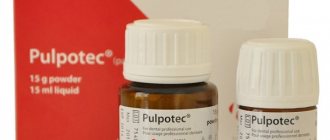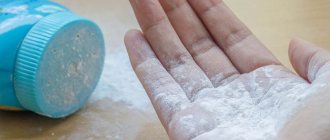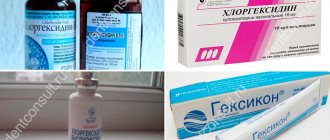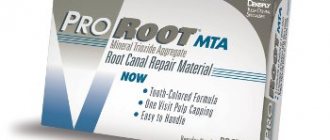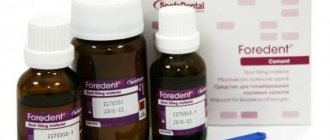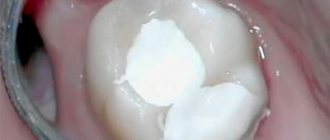Bactericidal and modified cements
— Unitem (Vladmiva) is a universal, improved zinc-phosphate dental cement with high mechanical strength and chemical resistance. The powder consists of zinc oxide, with modifying additives, and the liquid consists of orthophosphoric acid of reduced activity.
— Unicem bactericidal (Vladmiva) is a universal improved zinc-phosphate dental cement containing the optimal amount of a bacteriostatically effective form of silver. Used in pediatric dentistry for filling temporary teeth.
— -Adhesor (Spofa Dental) – zinc-phosphate cement, Adhesorfine (Spofa Dental) – modified zinc-phosphate cement with a fine structure.
— Phosphate cement containing silver. To improve the bactericidal properties, silver (1.547%) is added to the powder composition. The material is recommended as an insulating gasket when filling molars with metal and other fillings, for filling canals, in pediatric dentistry for filling temporary teeth. Analogs: Bactericidal Unitem (Vladmiva).
— Visphat cement refers to zinc phosphate cements. Its powder contains about 3% bismuth oxide. It hardens faster, is stronger than phosphate cement, and is less soluble. It is used as an insulating lining when filling teeth with metal fillings, silicate cements, acrylic and epoxy resins.
— Dioxyvisfate Dioxidine is included in the composition of this cement. Dioxyvisfate powder is a mixture of visfate and dioxidine, the liquid is orthophosphoric acid, partially neutralized with zinc oxide and aluminum hydroxide. Cement has bactericidal properties, has high mechanical strength, is slightly soluble, and is intended for filling temporary teeth, as a therapeutic and insulating spacer, for fixing inlays, pin teeth, and bridges.
Homework to understand the topic of the lesson:
Control questions:
1. What is the chemical composition of zinc phosphate cement powder and liquid?
2. What is the chemical composition of polycarboxylate cement powder and liquid?
3. What is the purpose of zinc phosphate cements?
4. What is the purpose of polycarboxylate cements?
5. Name the materials from the group of zinc-phosphate cements of domestic and foreign production.
6. Name the materials from the group of polycarboxylate cements of domestic and foreign production.
Classification of sealers (endosealers)
The classification of sealers includes, of course, not only newer materials, but also those that are no longer used in modern dentistry or are used in budget appointments. But for the historical aspect, and for general development, it would be nice to orientate ourselves in them.
Sealers are divided according to their consistency and combination of properties into:
- Plastic;
- Filers are primary solid.
Plastic sealers include non-hardening sealers and hardening sealers in their group. Currently, non-curing sealers are not used. Firstly, it is quite difficult to qualitatively fill the space between the dentin of the canal and gutta-percha, so as not to remove the material beyond the apex of the root, secondly, this group of materials has the super ability to dissolve under the influence of moisture, and at the end we have a poor-quality root canal filling, a newly developed pathological process.
A wide range of materials is included in the group of plastically hardening materials, including:
- Sealers based on resorcinol - formaldehyde resin;
- Sealers based on phosphate cement;
- Sealers based on epoxy resins;
- Sealer based on zinc oxide and eugenol;
- Sealer as an adhesive system;
- Polymer sealer with calcium hydroxide;
- Sealers based on silicone resin.
Sealer based on resorcinol - formaldehyde resin
Here you won’t open America to anyone - sealers based on resorcinol and formaldehyde resin are not used, because:
- A sealer based on resorcinol - formaldehyde resin has a high shrinkage, therefore, loss of high-quality sealing;
- Tooth staining pink;
- Formalin not only has a toxic effect on the body, but is also carcinogenic!
However, no matter how bad they talk about the bad qualities of a sealer based on resorcinol - formaldehyde resin, the sealer is currently being produced. All this is due to the bactericidal effect of formaldehyde.
in some cases, you can use a sealer based on resorcinol - formaldehyde resin, but extremely rarely:
- Gangrenous pulpitis;
- There is no way to pass through channels efficiently when they are either too narrow or curved;
- For some forms of apical periodontitis.
Sealers based on phosphate cement
Sealers based on phosphate cement were very common for some time, especially the peak of popularity occurred in the second half of the 20th century. Such a popular sealer based on phosphate cement was explained, first of all, by its active bactericidal effect and lack of sensitivity to moisture.
But the biggest disadvantage of this sealer is inflammation of the peri-root tissues due to the removal of the sealer beyond the root apex. In addition, this sealer has more disadvantages than advantages:
- Lack of radiopacity;
- Porosity of the material;
- Inconvenient working hours – fast curing;
- Impossibility of filling the root canal.
For this reason, sealers based on phosphate cement are of historical interest only.
Sealers based on epoxy resins
Sealers based on epoxy resins were insensitive to moisture, this was their main advantage, which dentists initially bought with the dream of filling root canals efficiently and without unpleasant consequences. However, epoxy resin sealers did not last long as a cool material.
Unitem white (50g+30ml), VladMiVa
Cement for fixing pins, crowns, bridges and inlays. Unitem has high mechanical strength and chemical resistance.
- Description
- Shipping and payment
- Reviews
Description
Unicem is a universal zinc phosphate cement formed by mixing zinc oxide powder and phosphoric acid solution.
Indications
- Fixation of crowns, bridges, pins, inlays.
- Filling teeth that are to be covered with a crown.
- Can be used as an insulating gasket when filling with silicate and silica-phosphate cements, as well as amalgams.
Characteristics
- Powder: 50 g.
- Bottle of liquid: 30 ml.
- Powder measuring cup: 1 pc.
- Dropper cap: 1 pc.
Compound
- Zinc oxide powder with modifying additives.
- Orthophosphoric acid of reduced activity.
Cement mixing process
Advantages
- High mechanical strength (90-120 MPa, depending on the ratio of powder and liquid).
- High adhesion to metal, plastic, porcelain, metal ceramics and other dental materials.
- Cement is resistant to the aggressive action of the moist environment of the oral cavity.
Instructions for use
- If the material has been stored or transported at low temperatures, it should be kept at room temperature for one hour before use.
- On a dry glass plate, gradually mix the powder and liquid in the required proportion.
- The mixing time should not exceed 1 minute.
- Apply cement to the previously treated and dried tooth surface.
- The hardening time of the cement is 2 hours; during this period it is recommended to cover the filling with varnish or hydrophobic gel to protect it from the action of saliva.
Fixation of prostheses
- 1 scoop of powder (0.25-0.30 g) + 4 drops of liquid (0.18-0.20 g).
- The dough remains plastic on glass for 2-2.5 minutes, and hardens in the oral cavity within 8 minutes.
Dental filling
- 1 scoop of powder (0.25-0.30 g) + 3 drops of liquid (0.13-0.15 g).
- The dough remains plastic on glass for 1-1.5 minutes, and hardens in the oral cavity within 6 minutes.
Storage
- Store in a dry place, protected from direct sunlight, in a tightly closed container.
- Storage temperature: from +5°C to +25°C.
- Avoid exposure to moisture.
- Shelf life: 5 years.
The Nika Dent company is the official distributor of VladMiV products. We supply dental materials and consumables throughout Russia.
Shipping and payment
PAYMENT METHODS
| Cash to the courier upon receipt of the goods. Possible: in Moscow, Moscow region, St. Petersburg, Leningrad region. |
| By bank transfer for legal entities by account. |
TRANSFERING THE ORDER TO THE DELIVERY SERVICE
For cash payments:
the next day after receiving the order, unless a different delivery date has been agreed upon.
For non-cash payments:
the next day after receiving the money to the bank account.
Please check with your manager about the possibility of same-day delivery.
DELIVERY METHODS
Delivery by our transport is carried out in Moscow, Moscow region, St. Petersburg and Leningrad region.
To all other regions, delivery is carried out by transport companies.
Pickup of goods from the warehouse and company office is not provided.
COST OF DELIVERY
| Within the Moscow Ring Road: when ordering over 3,000 rubles - free. Up to 3,000 rubles – we temporarily do not deliver. |
| IN ST. PETERSBURG : when ordering over 3,000 rubles - free. Up to 3,000 rubles – delivery cost 350 rubles. |
| IN THE MOSCOW REGION: up to 50 km from the Moscow Ring Road: for orders over 5,000 rubles - free. Up to 5000 rubles – we temporarily do not deliver. 50-100 km from the Moscow Ring Road: for orders over 30,000 rubles - free. Up to 30,000 rubles – we temporarily do not deliver. |
| IN THE LENINGRAD REGION: up to 20 km from the Ring Road: for orders over 5,000 rubles - free. In all other cases - individually |
| TO OTHER REGIONS The minimum order amount to the regions is 3,000 rubles. Delivery is carried out by a transport company. The cost of delivery to the Moscow base of the transport company is free. Payment for the services of the transport company is at the expense of the client. We work with any Transport companies convenient for you! |
Repeated delivery due to the buyer's fault will be paid in any case!
Reviews
There are no reviews for this product yet. Be the first to leave a review!
Cement filling materials
Zinc phosphate cements
They are a combination of powder and liquid. The main component of the powder is zinc oxide (75-90%) with the addition of other modifying oxides: magnesium oxide (5-13%), silicon dioxide (0.05-5%), etc. The liquid is an aqueous solution of 38-44% concentration of orthophosphoric acid containing phosphates of zinc, aluminum and magnesium. Phosphate cement is a filling material (TU 64-2-160-77) produced by the Lenmedpolymer production association, intended for filling tooth root canals and as a cushioning material when filling with other permanent filling materials. The kit includes 50 g of powder, 30 g of liquid, wax and glass sticks (pipette, dropper). The color of cement is light yellow. When filling the root canals of a tooth root, phosphate cement is mixed until a creamy consistency is obtained, which remains in a plastic state on glass for 7-8 minutes. For laying, cement is mixed in the ratio: 1 part liquid with 2.5 parts powder or 4-6 drops of liquid with 1 g powder. The cement should form a thick mass. To properly prepare the cement mass, it is mixed with a chrome-plated or nickel-plated metal spatula on the smooth surface of a glass plate at a temperature of 18-20°C. If the room temperature is above 25°C, the plate should be cooled in cold water for 2-3 minutes. While kneading, the powder is divided into 4 parts, one of them is divided in half, one of the eighth parts is halved again. The mixing process should begin immediately after applying the liquid to the glass. The liquid should be taken with a glass rod or using a dropper. First, mix ¼ of the powder with the liquid, thoroughly mixing the mass on a small area of the plate with spreading movements of a spatula. Having obtained a homogeneous mass, add sequentially, mixing thoroughly, ¼, 1/8 and 1/16 of the powder. The mixing time should not exceed 1.5 minutes. The cement mass is considered to be prepared correctly if, when the spatula is torn off, it does not stretch, but breaks off, forming teeth no more than 1 mm high. In the case of preparing cements as a cushioning material and for filling, efforts should be made to overcome the viscosity of the cement mass and ensure maximum contact of the powder with the liquid. If the consistency is too thick, you cannot add liquid, as this will disrupt the crystallization process of the cement. In this case, a new batch of cement should be prepared. Phosphate cement is introduced into the prepared cavity in small portions with thorough condensation to all walls of the cavity. The cement mass at the time of its introduction into the cavity must be in a sufficiently plastic state to ensure adhesion of the cement to the walls of the cavity. Phosphate cement should be stored in a dry place at a temperature of 15-25°C. Lower or higher temperatures promote crystallization of the liquid. Bottles with powder and liquid must always be closed. Storing a liquid in an open form leads to a change in its density, which negatively affects the setting time of cement and its strength. The penetration of foreign substances into powder and liquid is unacceptable: the slightest contamination of cement reduces its quality. It is necessary to strictly monitor the consistency of the powder and liquid (the use of powder and liquid of different series is prohibited). The shelf life of phosphate cement is 3 years.
Insulating gaskets must perform the following functions
- be non-toxic to the dental pulp;
- remineralize dentin tissue;
- protect soft and hard tooth tissues from irritants, as well as reduce tooth sensitivity after filling and preparation procedures;
- promote better fixation of the filling;
- do not affect the physical and chemical properties of the permanent filling;
- be sufficiently resistant to the effects of liquids formed in the oral cavity;
- have fast hardening and excellent adhesive properties in relation to tooth tissues;
- provide a hermetic coating of the bottom of the carious cavity;
- be resistant to chewing loads.
Insulating spacers are also used as separating planes when the components used for filling are incompatible, for example, composite fillings and eugenol-based pastes.
Zinc phosphate cement.
Zinc phosphate cement (ZPC) is formed by mixing powder and liquid on a glass plate with a spatula. The powder is mainly zinc oxide, and the liquid is an aqueous solution of phosphoric acid. CFC is used in two different consistencies, which can be achieved by mixing - a creamy consistency and a thicker one. Hardening time is a few minutes. It depends on various factors:
- If the glass plate on which the CFC is mixed. warm, then hardening occurs somewhat faster.
- CFC with a thick consistency hardens faster than CFC with a creamy consistency.
- CFC must be mixed on a dry plate because moisture inhibits hardening. To prevent the absorption of moisture from the air, the bottle with the liquid should be tightly closed, otherwise, when mixing the next portion, the CFC will harden too quickly.
- If a long hardening time is required, for example when fixing a bridge, a cold glass plate should be used. You need to add the powder in small portions. The ability to control the hardening time of CFC is one of the main positive properties of this type of cement.
Knowing the amount of powder and liquid required will come with experience. However, usually at the beginning of their practice, each nurse pours out either too much or, conversely, too little powder. If the amount of powder poured out was not enough, it can be added from the bottle with the clean end of a spatula, otherwise all the powder remaining in the bottle will be spoiled. Excessive powder can be poured back into the bottle only if you are sure that it has not come into contact with either the liquid or the already mixed cement.
To mix zinc phosphate cement, it is necessary to use a thick glass plate, because a thin glass plate gets hot from the nurse's hands and this leads to the cement hardening too quickly.
Application
CFC has a thick consistency and hardens very quickly; it can be used as:
- temporary filling;
- cushioning material;
- to isolate unevenness of the cavity bottom when preparing a tooth for inlays or crowns.
- CFC with a creamy consistency hardens more slowly and can be used for fixing:
- inlays, crowns and bridges;
- orthodontic ring.
Positive properties
A positive property of this type of cement is that it hardens completely within a few minutes, so it is very reliable as a cushioning material for a permanent filling, as well as a temporary filling. In addition, CFC can be used for fixation of various orthopedic structures.
Negative properties
Zinc phosphate cement cannot be used in deep cavities because it has a toxic effect on the dental pulp. In such cases, either a different type of cement is used, or calcium hydroxide is first placed at the bottom of the cavity, and only then CFC. Zinc phosphate cement is very sensitive to moisture, so the tooth cavity must remain dry.
smile-center.com.ua
Zinc phosphate cements
June 19 at 9:50 18284
Zinc phosphate cement is one of the first cements to appear in dental practice, which is still widely used today. This cement is a white powder that is mixed with a clear liquid. The powder is mainly zinc oxide with about 10% magnesium oxide added, the liquid is 45 - 64% phosphoric acid.
Release form
Powder
The powder is fired at temperatures above 1000T for several hours to reduce its reactivity and ensure appropriate working time and cement hardening time; material that was not fired would harden too quickly. Magnesium oxide is added to give the cement a white color, to make the zinc oxide powder more friable, and to increase the compressive strength of the cement. Other oxides (such as silica and aluminum oxide) were added in small amounts (up to 5%) to improve the mechanical properties of the cured material and provide a range of color shades. Some formulations contain fluorides (usually in the form of a small percentage of stannous fluoride), and are generally recommended for use in applications where the presence of fluoride is particularly indicated, such as the cementation of orthodontic appliances.
Liquid
The liquid is buffered by the addition of oxides present in the powder and aluminum hydroxide, which serve to form phosphates in it. Zinc is an essential element for the cement formation reaction, resulting in the formation of amorphous zinc phosphate, while aluminum reduces the reaction rate, guaranteeing the required working time of the cement. Achieving the required working time also depends on maintaining the powder-liquid ratio.
Hardening reaction
When zinc oxide is mixed with an aqueous solution of phosphoric acid, the surface layer of the powder particles is dissolved by the acid and acid zinc phosphate is first formed: This is followed by a further reaction in which, in the second phase of the process, hydrated zinc phosphate is formed: This substance is practically insoluble and crystallizes to form a phosphate matrix that binds together unreacted zinc oxide particles. The reaction is slightly exothermic, accompanied by some shrinkage of the cement. It is believed that the presence of aluminum in commercial grades of cement prevents the crystallization process, thereby forming a glass matrix in the form of an aluminophosphate gel. The presence of magnesium also inhibits crystallization, because the presence of this element prevents crystallization of any kind. Over time, some crystallization may still occur to form hopeite crystals. Unbound water forms globules in the cement and makes it highly permeable, so the dried material is porous. The final structure of the cement is particles of unreacted zinc oxide in a matrix consisting of zinc, magnesium and aluminum phosphates.
Properties
Summarizing the accumulated experience in the use of zinc phosphate cement, it can be noted that this fixation material has been and is one of the widely used materials, demonstrating excellent clinical results. This cement has a clearly required working time and a fast hardening time.
Working time and curing time
The working time for most brands of zinc phosphate cement when used for fixation is usually about 3 - 6 minutes. Depending on the mixing method, hardening time can vary from 3 to 14 minutes. Depending on the purpose, the cement is mixed either with a thick consistency, if it is used as a cushioning material, or liquid - when fixed dentures are fixed with cement. The cement powder and liquid are mixed, gradually adding the powder to the liquid, first in small portions, and then increasing the portions. At the end of mixing, add the powder again in small portions to ensure that the consistency of the mixture does not become thicker than required. Increased working time and curing time can be achieved by mixing the powder and liquid over a larger area of the plate. This helps to remove the heat of reaction which otherwise speeds up the hardening of the cement. On the contrary, quickly introducing the entire amount of powder into the liquid will reduce both the working time and the hardening time. The result will be a thick mixture with a low powder-to-liquid ratio due to the curing process starting too early. A low powder content in the mixture will lead to low quality cement. By using a cooled glass plate for mixing, you can increase the working time while maintaining the same curing time. This technique also has the advantage that it allows more powder to be introduced into the liquid, thereby increasing the strength and reducing the solubility of the material. However, great care must be taken when using this mixing technique as there is a danger of additional water being introduced into the mixture from the surface of the plate, either by not drying it sufficiently or by moisture condensing on it. In both cases, working hours will decrease. The combination of the use of chilled glass in the cement mixing technique and the dosed process of adding powder to liquid guarantees the required working time. The mixing process should be completed in 60-90 seconds. The curing time can be increased by using the so-called liquid slaking method, in which a small amount of powder is added to the liquid a minute before the main mixing process begins. The consistency of the paste depends on the powder-liquid ratio, and it is important to maintain the exact ratio of these components, based on the specific purpose of the cement in the clinic. For example, a powder-to-liquid ratio that is too low will result in a weak and highly soluble material with an unacceptably low pH. It must be borne in mind that sometimes in practice it is difficult to follow the manufacturer's recommendations for the optimal powder-liquid ratio, since existing methods of dosing components are not very accurate. Consequently, most dentists prefer to add a sufficient amount of powder to the liquid to obtain the consistency of the material appropriate for its specific use in the clinic. This situation makes it even more important that the procedure adopted and the reproducibility of the cement mixing process be maintained. The liquid is stored in a closed bottle. If the bottle is kept open, the loss of water due to evaporation will lower the pH level of the liquid and it will become more concentrated, which usually results in a slower curing process. As water evaporates and is lost, phosphoric acid will begin to separate from the solution, and the liquid will take on a cloudy appearance. In this case, the liquid becomes unsuitable for use.
When using cement as a cementing material, it is important not to pre-dispense the powder and liquid by placing them on the glass plate sooner than necessary, as the water may evaporate and this will slow down the setting reaction. You should also not leave the mixed material for a long time, since the hardening reaction begins almost immediately after mixing. If the paste is left for a long time, its viscosity may increase to such an extent that the material no longer has the necessary fluidity.
Biocompatibility
A fresh mixture of zinc phosphate cement has a pH in the range of 1.3-3.6. This low reading can persist for a considerable period of time and it will take about 24 hours for the pH to reach a neutral level. When cement is placed on a heavily prepared tooth, the low initial pH level can cause an inflammatory reaction in the pulp. This is especially dangerous if there is suspicion of opening the pulp chamber even in micro-areas. It should be remembered that the more fluid the mixture, the lower the pH level will be, and the longer it will take for the cement to reach a neutral pH level. Zinc phosphate cement does not have antibacterial properties, which means that combined with the slight shrinkage it sets, it will not provide an ideal barrier to bacterial penetration. Thus, the sensitivity of the pulp associated with the use of this material may be due to a combination of such properties of cement as shrinkage during hardening, lack of antibacterial action and increased acidity at the initial moment of placing the mixture, and not just acidity alone, as is commonly believed. The patient may experience some pain during the cementing process. They can be caused by both the low pH of the cement mixture and the osmotic pressure caused by the movement of fluid through the dentinal tubules. As a rule, such sensations are temporary and disappear within a few hours. The presence of constant irritation of the pulp can be caused by using too thin a cement mixture. The hardening process of zinc phosphate cement requires considerable time and during the first 24 hours there is a significant release of magnesium with a small amount of zinc. What biological effect the presence of these different ions may have on surrounding tissue remains unknown.
Mechanical properties
The mechanical properties of the material, like all others, are closely dependent on the powder-liquid ratio in the cement. Compressive strength can vary from a minimum of 40 MPa to 140 MPa. There is a linear relationship between powder-liquid ratio and compressive strength. During the first 10 minutes, a rapid increase in the strength of cement is observed, which reaches 50% of the final strength. It then increases at a slower rate, reaching the final value after about 24 hours. Cement is extremely brittle, as evidenced by its very low tensile strength, ranging from 5-7 MPa. The elastic modulus is approximately 12 GPa, which is close to the elastic modulus of dentin.
Consistency and film thickness of the fixing material
To ensure a good fit of a restoration using zinc phosphate cement as a luting material, the ability of the cement to form a very thin film is of great importance. After mixing, the powder is partially dissolved in acid so that the final size of the powder particles remaining in the structure of the hardened cement ranges from 2 to 8 microns. Since the mixture spreads easily, film thicknesses of less than 25 microns can be achieved. This is consistent with cementing purposes, but the thickness of the layer largely depends on the mixing technique used. The viscosity of the mixture increases very quickly over time. Within a couple of minutes, the viscosity can already be quite high, although the material itself is still quite manageable. However, it is not recommended to delay cementation of crowns, since increased viscosity, and therefore a thicker mixture, can lead to a significant thickening of the cement layer and, consequently, to unsatisfactory fixation of the restoration.
Solubility
An important indicator is the solubility of cement, especially when used as a material for fixation. The solubility of the material affects the marginal permeability around the restoration, crown or inlay, and leads to the penetration of bacteria. This can cause both loosening of the restoration and, more likely, stimulate the occurrence of secondary caries. During the first 24 hours after hardening, cement is highly water soluble and material loss can range from 0.04 to 3.3% (acceptable upper limit of 0.2%). After this time, the solubility decreases significantly. In general, the level of solubility is largely dependent on the powder to liquid ratio when mixing the cement, and the higher the ratio, the more stable the cement. Upon completion of the final stage of hardening, the material becomes slightly soluble in water (while retaining the ability to some release of zinc and phosphate ions), but remains susceptible to the action of lactic acid. Since some time passes before final hardening, it is important to avoid excessive exposure of the cement to oral fluids. Fluoride-containing cements have the property of continuously releasing fluorides over a long period of time. The absorption of fluoride by the surrounding enamel reduces the likelihood of its demineralization and especially when using orthodontic appliances.
Practical use
Most often, zinc phosphate cements are used as a luting material for cementing metal, metal-ceramic crowns and bridges, although it is also used for other purposes, such as the luting of orthodontic appliances, and as a material for temporary fillings. These cements exhibit a number of positive qualities; they: • mix easily • have a clear (sharp), well-defined hardening • have a sufficiently high compressive strength, which allows them to withstand the loads that arise during amalgam condensation • are a cheap product. Ease of use or manufacturability, as well as their acceptable properties for attaching fixed dentures, have made zinc phosphate cements very popular materials among dental practitioners for a whole century. However, these cements also have the following disadvantages: • can be irritating to the dental pulp due to the low pH level • do not have an antibacterial effect • are brittle • do not have adhesive properties • are relatively soluble in the oral environment. These factors may influence the occurrence of secondary caries during the fixation of cast denture structures.
Clinical significance
Zinc phosphate cements have been used for over a hundred years and, despite their disadvantages, they will continue to be used for many years in the future for cementing metal and metal-ceramic restorations.
Fundamentals of Dental Materials Science Richard van Noort
medbe.ru
